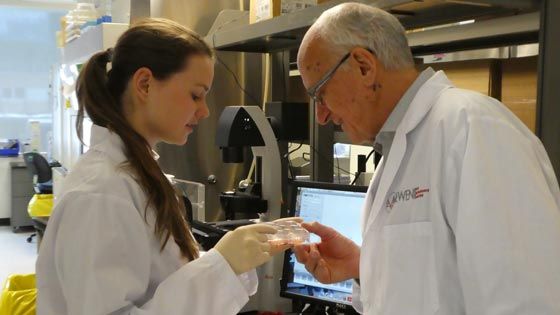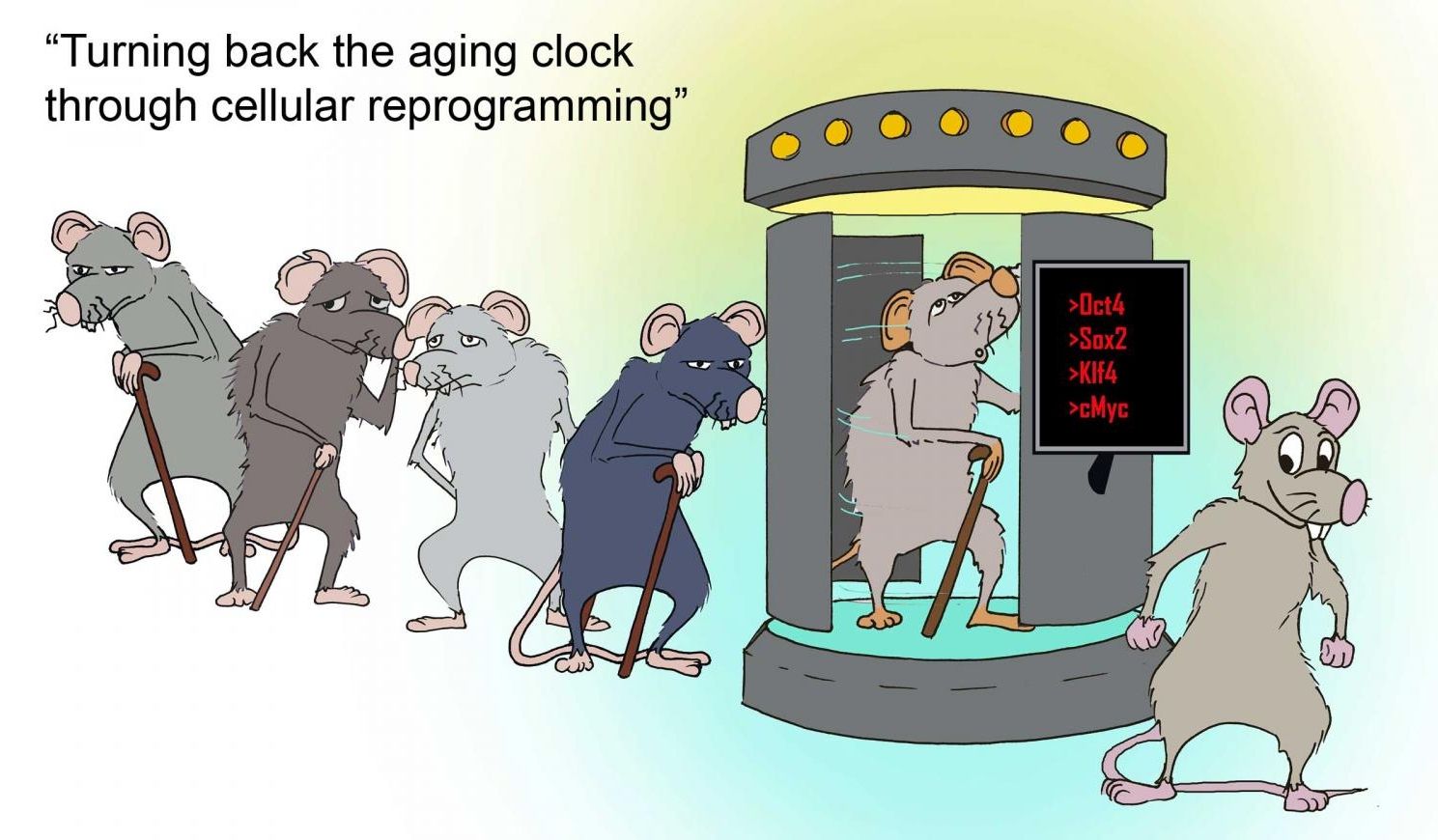Could artificial intelligence help address the mental-health crisis among Syrian refugees?


Is it safe to remove senescent cells? This is a common question we hear when talking about senolytic therapies designed to remove these problem cells that accumulate with age and play havoc with the body and its ability to repair.
Mantas from CellAge answers a question from one of our readers about senescent cell removal therapy. The removal of senescent cells has become a very hot topic this year with numerous experiments showing positive results for health and disease mitigation.
Check out the campaign at Lifespan.io and donate to a better healthier future:
https://www.lifespan.io/campaigns/cellage-targeting-senescen…c-biology/

The body is under constant invasion by microbes so rejuvenation of the immune system and reduction of imflammation is a big priority for rejuvenation biotechnology.
Recent publications have proposed that aging should be classified as a disease (Bulterijs et al., 2015; Zhavoronkov and Bhullar, 2015; Zhavoronkov and Moskalev, 2016). The goal of this manuscript is not to dispute these claims, but rather to suggest that when classifying aging as a disease, it is important to include the contribution of microbes.
As recently as ~115 years ago, more than half of all deaths were caused by infectious diseases, including pneumonia, influenza, tuberculosis, gastrointestinal infections, and diphtheria (Jones et al., 2012). Since then, the establishment of public health departments that focused on improved sanitation and hygiene, and the introduction of antibiotics and vaccines allowed for a dramatic decrease in infectious disease-related mortality (Report, 1999). In 2010, the death rate for infectious diseases was reduced to 3% (Jones et al., 2012). Simultaneously, as infectious disease-related mortality rates have decreased, global lifespan has increased from ~30 to ~70 years (Riley, 2005).
Because death rates due to infectious diseases have been reduced to very low levels, we’ve forgotten about the adverse effects of microbes on our existence. The fact is, we live in a microbial world. Although there are currently ~7 billion people, in contrast, the total number of prokaryotes and viruses have been estimated at 1030 and 1031, respectively (Whitman et al., 1998; Duerkop et al., 2014). Even without including other microbes (e.g., fungi, protozoa), humans are outnumbered by more than 1021 to 1! All of these microorganisms aren’t detrimental to human health, but more than 1400 microbial species have been shown to be pathogenic (Taylor et al., 2001).

The bionic pancreas system developed by Boston University (BU) investigators proved better than either conventional or sensor-augmented insulin pump therapy at managing blood sugar levels in patients with type 1 diabetes living at home, with no restrictions, over 11 days. The report of a clinical trial led by a Massachusetts General Hospital (MGH) physician is receiving advance online publication in The Lancet.
“For study participants living at home without limitations on their activity and diet, the bionic pancreas successfully reduced average blood glucose, while at the same time decreasing the risk of hypoglycemia,” says Steven Russell, MD, PhD, of the MGH Diabetes Unit. “This system requires no information other than the patient’s body weight to start, so it will require much less time and effort by health care providers to initiate treatment. And since no carbohydrate counting is required, it significantly reduces the burden on patients associated with diabetes management.”
Developed by Edward Damiano, PhD, and Firas El-Khatib, PhD, of the BU Department of Biomedical Engineering, the bionic pancreas controls patients’ blood sugar with both insulin and glucagon, a hormone that increases glucose levels. After a 2010 clinical trial confirmed that the original version of the device could maintain near-normal blood sugar levels for more than 24 hours in adult patients, two follow-up trials — reported in a 2014 New England Journal of Medicine paper — showed that an updated version of the system successfully controlled blood sugar levels in adults and adolescents for five days. Another follow-up trial published in The Lancet Diabetes and Endocrinology in 2016 showed it could do the same for children as young as 6 years of age.

Senescent cell removal is the first true rejuvenation therapy to treat one of the aging processes and with human clinicial trials in the next 18 months these are some very exciting times. Here is yet another study showing natural compounds can be used in combination with drugs to kill senescent cells.
Today’s open access research paper outlines the discovery of yet another new candidate drug for the selective destruction of senescent cells. This is an increasingly popular research topic nowadays. Senescent cells perform a variety of functions, but on the whole they are bad news. Cells become senescent in response to stresses or reaching the Hayflick limit to replication. They cease further division and start to generate a potent mix of signals, the senescence-associated secretory phenotype or SASP, that can provoke inflammation, disarray the surrounding extracellular matrix structures, and change behavior of nearby cells for the worse. Then they destroy themselves, or are destroyed by the immune system — for the most part at least. This is helpful in wound healing, and in small doses helps to reduce cancer incidence by removing those cells most at risk of becoming cancerous. Unfortunately a growing number of these cells linger without being destroyed, more with every passing year, and their presence eventually causes significant dysfunction. That in turn produces age-related disease, frailty, and eventually death. Senescent cells are not the only root cause of aging, but they provide a significant contribution to the downward spiral of health and wellbeing, and even only their own would eventually produce death by aging.
The beneficial aspects of senescent cells seem to require only a transient presence, so the most direct approach to the problem presented by these cells is to destroy them every so often. Build a targeted therapy capable of sweeping senenscent cells from tissues, and make it efficient enough to keep the count of such cells low. That is the way to prevent senescent cells form contributing to age-related disease. Working in mice, researchers have produced results such as functional rejuvenation in aged lungs and extended life span through the targeted destruction of senescent cells. Since perhaps only a few percent of the cells in old tissue are senescent, this targeted destruction can be accomplished with few side-effects beyond those generated by off-target effects of the medication itself.

Tissue engineering and Stem cells are a large part of the rejuvenation biotechnology toolkit. Here we have yet more progress and this time the pacemaker cells are replicated for possible use in biological pacemaker therapies.
“Scientists from the McEwen Centre for Regenerative Medicine, University Health Network, have developed the first functional pacemaker cells from human stem cells, paving the way for alternate, biological pacemaker therapy.”

Scientists are able to use brain tests on three-year-olds to determine which children are more likely to grow up to become criminals. It sounds like Minority Report come to life: An uncomfortable idea presenting myriad ethical concerns. But, though unnerving, the research is nuanced and could potentially be put to good use.
In the study, published in Nature Human Behavior this week, researchers led by neuroscientists at Duke University showed that those with the lowest 20% brain health results aged three went on to commit more than 80% of crimes as adults. The research used data from a New Zealand longitudinal study of more than 1,000 people from birth in the early 1970s until they reached 38 years old. This distribution, of 20% of a population accounting for 80% of an effect, is strong but not unusual. In fact, it follows the “Pareto principle.” The authors write in their paper:
In Pareto’s day, the problem definition was that 20% of families owned 80% of land in Italy. The so-called Pareto principle is alive and useful today: for example, in software engineering, 20% of the code is said to contain 80% of the errors.

An interesting but predictably hyped research study currently doing the rounds. Epigentic changes are one of the Hallmarks of Aging and this study reinforces their importance despite the usual media hype.
Graying hair, crow’s feet, an injury that’s taking longer to heal than when we were 20—faced with the unmistakable signs of aging, most of us have had a least one fantasy of turning back time. Now, scientists at the Salk Institute have found that intermittent expression of genes normally associated with an embryonic state can reverse the hallmarks of old age.
This approach, which not only prompted human skin cells in a dish to look and behave young again, also resulted in the rejuvenation of mice with a premature aging disease, countering signs of aging and increasing the animals’ lifespan by 30 percent. The early-stage work provides insight both into the cellular drivers of aging and possible therapeutic approaches for improving human health and longevity.
“Our study shows that aging may not have to proceed in one single direction,” says Juan Carlos Izpisua Belmonte, a professor in Salk’s Gene Expression Laboratory and senior author of the paper appearing in the December 15, 2016 issue of Cell. “It has plasticity and, with careful modulation, aging might be reversed.”
We already know that excessive amounts of stress long term can cause certain individuals with certain predisposition cancer genetic mutations can cause cancer such as breast cancer. So, not surprise to see this.
In some situations, people who got hurt, replay the disturbing moment in their heads for many times and for many days. Every repetition you make usually causes more intense feelings making the situation worse.
Thanks to modern medicine, there is now proof that keeping these emotions inside you can have negative effects on your overall health. That’s why we would like to discuss forgiveness.
When it comes to clinical view, forgiveness is a process where a person gives up from the feeling of bitterness and thoughts associated with retribution.

This is just wrong; its a disgrace to all things Quantum.
NEW YORK, Dec. 15, 2016 /PRNewswire/ — Beard Basics offers a full line of men’s beard grooming products as well as a year-round line of their version of beard baubles beard bauble ornaments for Christmas and special occasions. In addition, they offer an everyday line of beard and hair ornaments, glitter beard kits and for 2016, the next generation of beard ornaments, Quantum Beard Lights Beard Fairy Lights.
Beard Basics, a full line of men’s beard grooming products and special occasion items, has been creating and selling men’s beard grooming and their version of beard Baubles with beard bauble ornaments for more than a decade. The company offers a full range of products including holiday, sports-themed and year round beard and hair ornaments. In 2014, the company launched holiday beard ornamentation as part of the beard season awareness for men’s health. Beard Basic’s brand of holiday Beard Bauble Ornaments and glitter beard kits have been copied by many other companies but they are the trend setters when it comes to beards and the first to offer beard ornaments with mini clips.